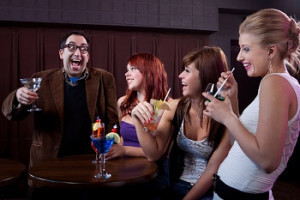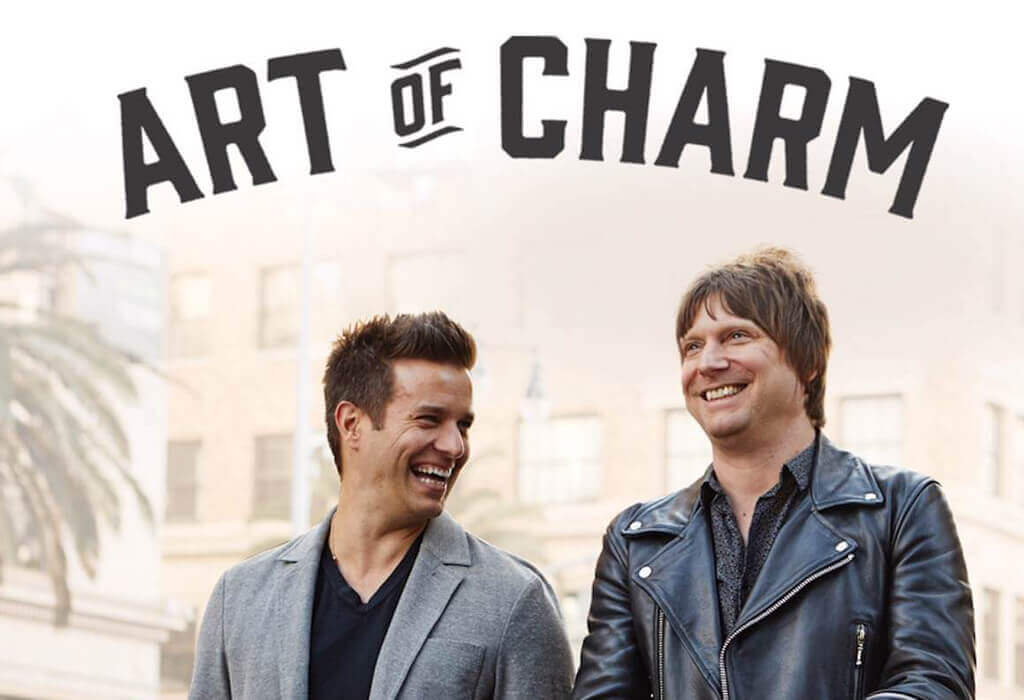 Ah, how to be authentic. Authenticity is one of those qualities that has become so desirable, so sought after, that it has been reduced — just like generosity and gratitude — to a meaningless cliché. And yet everything we teach at The Art of Charm, from storytelling to approaching to confronting limiting beliefs, seems to come back to the core concept of being who you are, which might just be the most difficult skill you can master. Authenticity is as elusive as it is powerful, but so many people are still baffled by the notion of how to be authentic.
Ah, how to be authentic. Authenticity is one of those qualities that has become so desirable, so sought after, that it has been reduced — just like generosity and gratitude — to a meaningless cliché. And yet everything we teach at The Art of Charm, from storytelling to approaching to confronting limiting beliefs, seems to come back to the core concept of being who you are, which might just be the most difficult skill you can master. Authenticity is as elusive as it is powerful, but so many people are still baffled by the notion of how to be authentic.
There’s something funny about the way we talk about authenticity. We want to learn authenticity. We want to react authentically. Authenticity is something we want to get. We treat being authentic as something we have, as opposed to something we are. Which can keep us from actually developing this trait, since we’re trying to attain something that, by definition, we already have.
If we define authenticity as simply being your true self, then we really shouldn’t have to look for it in the first place. If we’re looking for it, then we’ve already lost it. And that is what we can call the paradox of authenticity.
If you’re trying to be authentic, you’re not being authentic.
So how can we possibly learn to become more authentic?
—
We have to start by understanding why authenticity is so important.
It might seem obvious, but it’s not. After all, we live in a world that thrives on inauthenticity. Traditional jobs run on office politics, the news feeds on false information, celebrities pretend to be real people, brands curate fan pages, even our friends put on nice faces or say what we want to hear to keep us happy. We don’t need to belabor the point, but it’s important to realize how much of our lives are driven by bullshit, which is the lack of authenticity.
But if you think about the moments in your life that are meaningful—I mean truly meaningful—you will always find a degree of realness, of true authenticity. A heartfelt compliment, an honest job review, a great movie, an actually enjoyable first date: these all involve at least some degree of authenticity.
The reason we recognize authenticity is that we’re primed to respond to it. And we’re primed to respond to it authentically. In short, we know it when we see it. And it feels good. It feels true. It feels like something real, which is why it resonates so strongly with us. If we put up with a world that is so often inauthentic, it’s only because we’ve forgotten what real authenticity feels like. But that only makes us hungrier for it, which explains why a politician with even a hint of truth or a speaker who dares to be vulnerable has the power to inspire us.
And when they do—how special! We can probably count those moments on one hand. They’re extraordinary. We feel moved by authentic people, we feel attracted to them. Similarly, we feel attractive when we are being authentic, and when we connect with someone who is authentically engaging with our attractiveness. When we have a killer job interview or a truly special date, what we’re usually saying is that we encountered a moment of mutual authenticity.
Being authentic is also a lot easier. It’s tempting to forget, but being yourself—and being around other people who are themselves—is much easier than pretending, or falsifying, or putting on a social mask, which are common ways to cope with a world that feels false. In fact, it’s inauthenticity that makes pick-up lines, memorized openers and canned responses so attractive. These techniques seem easier, until we discover that they only go so far. They break down as soon as a relationship demands real authenticity, at which point we realize how much easier it would have been to just be ourselves.
So on multiple levels, we’re craving that realness: we want to be authentic, and we want to be around authenticity. The more we try to be something else—what our parents told us we should be, what our jobs demand us to be, what other people seem to think we should be—the more the desire to just be ourselves grows stronger.
If you need any more evidence for why this trait is so important, ask yourself whether you feel better being yourself or pretending otherwise. I think if we’re being honest, it always feels better to be authentic. If it ever feels better to be inauthentic, it’s only because we haven’t quite learned how to be ourselves.
So if authenticity is something we all want, but it’s impossible to have, since it’s something you are and not something you get, then authenticity must be impossible to teach, right?
As I like to say, teaching someone how to be authentic is like teaching someone to be taller. It might even be worse, because no one can fake being taller, but they can definitely fake being authentic. In fact, they do it all the time, as we just discussed.
So how can you learn to become more authentic?
As we’ve already discovered, you can’t. That’s the trap.
What you can do, however, is stop being inauthentic.
And that’s where we’ll begin.
—
If authenticity is the feeling of being your real self, then we can define inauthenticity as the feeling of not being your real self.
That can take many forms: masquerading as someone you’re not, compromising what you feel is right, feeling strange in your own skin, mimicking those around you, or generally feeling like you’re not one with your day-to-day experience.
You might recognize inauthenticity as a kind of pretending. It comes along with feelings of fraudulence, deception, self-consciousness, and the feeling that you need to keep up appearances. For many of us, that describes our work personas. For others, that describes who we are in a relationship.
These patterns can become so ingrained that being authentic seems more uncomfortable than faking it. Once we’ve gotten to that point, we can be pretty sure it’s time for a change.
Now, we should pause here and make an important distinction. At its core, inauthenticity does not feel truly comfortable. But let’s not confuse inauthenticity with discomfort. These are two different things.
For example, you might feel uncomfortable approaching a stranger at a bar. But that doesn’t mean approaching a stranger is inauthentic. You can have your experience of being uncomfortable talking to a stranger while remaining authentic about just how uncomfortable you really are.
In fact, that’s exactly what our residential programs are all about: trying new techniques, feeling the discomfort, and being honest—that is, authentic—about how uncomfortable those techniques can feel at first. Over the program, we work through the self-consciousness, and what felt uncomfortable becomes normal, and what felt inauthentic becomes real.
(By the way, that explains why “flawed” approaches can sometimes work really well. I’ve seen guys walk up to girls, tell them how nervous they are to say hello, and go on to have great conversations. At the very least, they’re not pretending, which frees them up to have a real moment. Humans—women especially—are authenticity lasers: They zero in on that shit. People know when they’re talking to the real thing.)
So remember: Discomfort is good, and is usually a sign that you’re being stretched. You might not normally go up to a stranger in a bar, but that doesn’t mean you’re being inauthentic by trying. As a great Harvard Business Review article explains, moving beyond our comfort zones can make us want to protect our identities by retreating to familiar behaviors and styles—behaviors and styles that don’t actually serve us, that aren’t who we really are deep down.
And that’s a corollary to the authenticity paradox: You can be inauthentic by doing what seems authentic (that is, what feels most comfortable), and you can be more authentic by trying things that feel inauthentic (that is, new thoughts and behaviors that are uncomfortable simply because they’re new).
Crazy, I know. But that’s how our minds can deceive us into avoiding who we really are.
—
So back to the problem: If we can’t try to be more authentic, then how can we become more authentic?
The first step is to stop being inauthentic. That’s how we get around the authenticity paradox.
It’s not that we’re learning how to be authentic, but that we’re un-learning inauthenticity.
And it turns out that un-learning inauthenticity is very doable.
The first step is to notice when it arises.
That’s it. Just notice it.
The moment you catch yourself being inauthentic—saying something you don’t believe, pretending to feel something you’re not—you’ll want to shake it off pretty quickly. The instinct will be strong, because there’s nothing fun or easy about pretending to be something you’re not. At the end of the day, we all just want to get back to being ourselves.
Then, listen to that instinct.
When you feel the bullshit arising, when you feel the discomfort of pretending to be someone you’re not, stop and pay attention.
That might seem obvious, and it is, but this is where most people—even people who are truly committed to becoming more authentic—get stuck. It’s one thing to notice the tendency to be inauthentic. It’s another to admit that it’s happening, right now, in you, and that there’s another way to be.
Next, take a moment and have a laugh.
Seriously. This is important. You catch yourself defending a point of view you might not really hold, or tolerating someone’s toxicity out of obligation, or fighting for a job you don’t really want. Whatever the situation, the moment you catch yourself having an inauthentic moment, stop and enjoy the discovery.
So you were being inauthentic just now—how funny! You forgot who you were for a moment. Now you remember. Well that was weird…
The other day I was on the phone with my partner, and we had just gotten a list of questions from a journalist interested in our company. The questions were a little strange, a little misleading, and totally out of left field. We spent a few minutes discussing them together, trying to come up with good answers, suddenly finding ourselves inarticulate and confused, each of us getting more worked up as we tried harder and harder to find answers to these not-so-great questions.
Suddenly, I stopped.
“I’m kind of stressed out,” I said.
“Me too!” he said.
And in that little moment, everything shifted. We both realized the questions were unhelpful. We both remembered that we totally knew how to talk about our business. And suddenly, we started coming up with new ideas, new talking points—and they were way better than what we were talking about a moment earlier.
I had been drawn in by a situation—in this case, a list of questions—and had quickly forgotten who I was: a guy who loves talking about what he does, who knows AOC inside and out, who’s excited to share our work with other people. I then started pretending to be this other guy who has clever answers to bad questions. That guy wasn’t a very good partner, and the moment I realized it, I knew I had to say something. After we both recognized our frustration and had a laugh, I remembered who I was, and suddenly I knew exactly what to do. I was back to being myself. I was authentic again.
Laughing at yourself in the moment will also help you avoid another tempting trap: Beating yourself up for being inauthentic. That’s not what we’re here to do. (In fact, I’d argue that being hard on yourself is a very inauthentic thing to do.) It doesn’t feel good, because it’s totally unnecessary. You’re human. It’s normal to slip into inauthentic moments. We’ve learned some funny behaviors from the world around us over the years. Sometimes we forget who we are. It’s all good.
Because when you notice the inauthenticity arising…
You just stop, notice it, and accept it…
And enjoy that moment of remembering who you really are…
You’re on your way toward being more authentic.
Which leads us to the last step in the process…
Finally, you have to be willing to put your inauthenticity aside.
That’s a little harder. A lot of us rely on our roles, our beliefs, our positions, our identities. They’re comforting. They’re familiar. They allow us to navigate the world in a safe and predictable way. Putting them down would mean losing something that we’ve been using, probably for a long time.
Because who are you without the persona? What are you going to say if you don’t give the bullshit compliment? Why are you at this party if you don’t know what to talk about? Do you belong in this meeting if you don’t know the answers?
That’s why a lot of what we do here at AOC is a subtractive process. In some cases, we’re here to add things to you—techniques, skills, sensibilities, frameworks. In other cases, we’re here to remove things—limiting beliefs, assumptions, fears, and—as a result—inauthenticity.
Ultimately, you don’t become more authentic by trying to be more authentic (remember the paradox!), but by removing all the other stuff—the hollow statements, the biased beliefs, the silly opinions, the feigned interest, the canned responses, the formulaic answers—that makes up your inauthenticity.
Authenticity isn’t the presence of something, but the absence of everything that isn’t authentic.
Let that sink in. You’re not here to add anything to become more authentic. You’re only here to take away anything that isn’t real. Remember that when you find yourself disconnected from who you really are, and you’ll quickly find a path back to a fun, enjoyable, authentic moment.
Once you put aside your inauthenticity, you’re left with only one option: You have to be yourself. You have no other choice. It’s a little scary, but it’s also liberating.
As Oscar Wilde said:
“Be yourself; everyone else is already taken.”




